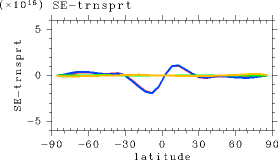F. Atmospheric Structure in the Runaway Greenhouse State |
e. Meridional Energy Transport
Figure 1 shows the meridional transports of dry static and latent heat energies from Experiment S1800. Again, the atmosphere in this case is not in a steady state so a residual exists in the budget presented in this figure. Specifically, the heating of the atmosphere is keeping to occur and the amount of residual water vapor accumulates in the atmosphere. Nonetheless, Figure 1 is presented here in order to examine the differences between the case in the runaway greenhouse state and those in equilibrium states. A comparison of the energy transports reveals that latent heat energy transport is larger than the dry static energy transport. This result is identical to that from Experiment S1570. In the present case, a meridional asymmetry is present in the distribution of the energy transport, which is a feature distinctively different from the cases in equilibrium states. Of the components contributing to the energy transport, the mean meridional circulation component dominates. Regarding the disturbances in mid-latitudes, it remains unclear whether they are caused by baroclinic instability or if they are CISK-induced. |
(a)  (b) |